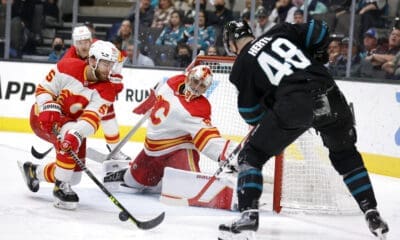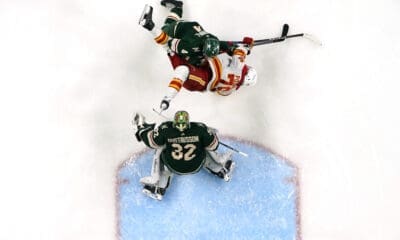Calgary Flames
The Best and Worst of the 2013 Flames, Part II
I continue my look back at the best and worst of the 2013 Calgary Flames.

Last time we looked at Mikael Backlund and TJ Brodie’s emergent seasons in 48-games for the 2013 Flames. Today we’ll check out how some of the older players on the team contributed in positive ways.
Matty Franchise's 23 points was five more than he had last season in just 43 games, but Stajan was also thrust into an increased role this year, facing the third toughest quality of competition amongst Flames forwards who played 30+ games, as well as more responsibility defensively. Stajan had the toughest zone start ratio of any regular Flames forward, starting in the offensive zone on just 42% of his shifts at even strength. On special teams, he played an average of 1:57 per game on the PK and just 0:15 on the powerplay. All 23 of his points came at even strength.
Stajan was rotated around the Flames' lineup a fair bit last season as Bob Hartley tried to find line combinations that would work for his team that just could not seem to string two wins together, and at one point he was the only natural centre in the Flames' lineup and as such was heavily relied upon in the faceoff circle, where he won just less than half of his draws.
Is he worth $3.5M for another season? Probably not, but if Stajan can replicate his 2013 play over the course of an 82-game season, I won't complain about him being on the roster next year on a Flames team that will likely be running in place for the time being.
Curtis Glencross and Lee Stempniak
The man we call Scoreface continued to defy the rules of regression this season as he led the Flames with 15 goals in 40 games and shot 16.3% His circumstances weren't exactly as tough as the likes of Stajan, Stempniak and Backlundd–Glencross had the most favourable offensive zone start of all regular Flames forwards at 49.3% and did not face the opposition's best as regularly as Backlund and Stempniak did, and he was plagued by inconsistency in the last month of the season before being injured by a knee-on-knee hit on April 19th. Nonetheless he remains a useful player who can take over a game when his emotions don't get the better of him, the type of player which the Flames will need going forward while he still has some good years left. Staying healthy will be crucial for him, however.
Lee Stempniak was a workhorse this past season. The 30-year-old forward played in all situations against the second-toughest competition of all regular Flames forwards at even strength. He also had the second-toughest zone start of all Calgary forwards, starting in the offensive zone on just 43.5% of his shifts. That he did all of this while managing to tie Mike Cammalleri for first in scoring on the team with 32 points is fairly impressive–and with only 12 PIMS in 47 games. Other than the kids and perhaps Glencross, Stempniak is one of the few Flames forwards who will provide full value for the $2.5M he will make next season at this point in his career.
Mike Cammalleri
Cammalleri remains one of the most offensively talented players on the Flames roster, and he comes with a hefty price tag to match. The 30-year-old shot 17.2% with 19 points in 28 games after being traded to the Flames in February of 2012, and was in line for a slight decline in 2013, but he was still above average in the shortened season. HIs 13 goals were second on the team to Glencross’ 15 and his 32 points co-led the team in total scoring with Stempniak. His five powerplay goals tied him with Jiri Hudler as the most dangerous player with the man advantage, and his 15 PP points made up 47% of his scoring. Cammy was deployed against easier competition than the likes of Backlund and Stempniak, but his zone start was the same as Backlund’s–45.4%.
The Flames' lack of multiple truly dominant scoring threats who can also drive possession to play alongside a player like Cammalleri combined with his sub-50% zone start, Cammy's on-ice possession numbers also suffered–he also finished his shifts in the offensive zone less than 50% of the time at even strength. The final year of his contract in 2013-14 will obviously be crucial to determining his future role with the team, and in order for him to continue to have success coach Hartley will likely either have to find a way to further improve Cammalleri's circumstances or to consistently deploy him with linemates who can drive the bus possession-wise.
Best of Runners-Up:
Wideman was less of a liability than many predicted this past season. He ate up ice time in all scenarios and his four goals and 13 points on the powerplay helped vault the Flames' man advantage unit into the top-10 in the league. His even strength possession numbers weren't abominable either.
The second-year forward was visibly improved after expressing very public disappointment at being sent down to the Abbotsford Heat following his recovery from a hip-flexor injury. Nine of his 10 points came after he spent a month in the minors, and Baertschi closed out the season on a seven-game point streak, including two multi-point games. Despite spending an average of 1:30/game on the powerplay, all of Baertschi's points came at even strength. He missed the final game of the season and the World Championships with a groin injury.
by Hayley Mutch









